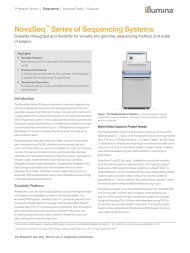Abstracts
ngsfinalprogram
ngsfinalprogram
Create successful ePaper yourself
Turn your PDF publications into a flip-book with our unique Google optimized e-Paper software.
Poster <strong>Abstracts</strong><br />
comparable to a recent study which reported<br />
mutation rates for different clades of a phylogenetic<br />
tree constructed from 73 enterococci<br />
isolates. The rate was 49 ± 3 SMY for a clade<br />
belonging to clonal complex CC17, and was<br />
3.6 ± 0.6 SMY and 13 ± 2 SMY for two<br />
clades with mixed STs. We have developed<br />
a method for mutation rate inference using<br />
SNPs obtained from NGS data. Standardizing<br />
the filtering process will allow expanding this<br />
approach to other species. With studies reporting<br />
variation in mutation rates within species<br />
such procedural methodology becomes all the<br />
more important. This bioinformatics approach<br />
to identify disease transmission paths can help<br />
recognize, control, and diagnose bacterial<br />
clinical outbreaks.<br />
n 21<br />
COMPARISON OF RNA AND DNA<br />
EXTRACTION KITS FOR VIRUS DETECTION<br />
BY NEXT GENERATION SEQUENCING (NGS)<br />
J. Klenner, C. Kohl, P. Dabrowski, A. Nitsche;<br />
Robert Koch Institute, Berlin, GERMANY.<br />
A crucial step in the molecular detection of<br />
viruses in clinical specimens is the efficient<br />
extraction of viral nucleic acids. The total yield<br />
of viral nucleic acid from a clinical specimen<br />
is dependent on the specimens’ volume, the<br />
initial virus concentration and the effectiveness<br />
provided by the extraction method. Recent<br />
Next Generation Sequencing (NGS)-based<br />
diagnostic approaches provide a molecular<br />
‘open view’ into the sample, as they generate<br />
sequence reads of any nucleic acid present<br />
in a specimen in a statistically representative<br />
manner. However, since a higher virus-related<br />
read output promises better sensitivity in the<br />
subsequent bioinformatic analysis, the extraction<br />
method selected determines the reliability<br />
of diagnostic NGS. In this study four commercially<br />
available nucleic acid extraction<br />
kits (QIAGEN, Hilden, Germany: QIAamp<br />
Viral RNA Mini Kit, QIAamp DNA Blood<br />
Mini Kit, QIAamp cador Pathogen Mini Kit<br />
and QIAamp MinElute Virus Spin Kit) were<br />
evaluated by NGS. The nucleic acid yields<br />
and sequence read output were compared for<br />
four different model viruses comprising Reovirus,<br />
Orthomyxovirus, Orthopoxvirus and<br />
Paramyxovirus, each at defined but varying<br />
concentrations in the same sample. The total<br />
nucleic acid extracted was divided into two<br />
aliquots; one was subjected to RNA and the<br />
other to DNA processing for NGS. The yield<br />
of nucleic acids was determined by Qubit and<br />
virus-specific quantitative real-time PCR. NGS<br />
libraries were prepared for sequencing on<br />
the Illumina HiSeq 1500 system. Finally, the<br />
percentage of reads which could be assigned<br />
to each virus after extraction with the different<br />
kits was determined via mapping. As presented<br />
here, evaluation of the different commercial<br />
nucleic acid extraction kits indicates little<br />
deviation in the numbers for RNA and DNA<br />
reads, depending on the kit used.<br />
n 22<br />
TRANSMISSION OF HIGH RISK K.<br />
PNEUMONIAE CLONES IN HEALTH CARE<br />
NETWORKS LARGELY CHALLENGES THE<br />
CURRENT INFECTION PREVENTION AND<br />
CONTROL SYSTEM<br />
K. Zhou, M. Lokate, R. H. Deurenberg, G. C.<br />
Raangs, H. Grundmann, A. W. Friedrich, J. W.<br />
Rossen;<br />
University of Groningen, University Medical<br />
Center Groningen, Groningen, NETHER-<br />
LANDS.<br />
Controlling dissemination of multidrugresistant<br />
pathogens remains one of the major<br />
challenges in hospitals and public health. Here<br />
we describe an inter-institutional transmission<br />
of an ESBL-producing ST15 Klebsiella pneumoniae<br />
between patients caused by patient<br />
referral. An epidemiological link between<br />
the patient isolates was supported by patient<br />
contact tracing and phylogenetic analysis of<br />
the isolates obtained from May to November<br />
2012 using next generation sequencing (NGS).<br />
By May 2013, a patient treated in two institutions<br />
in two cities was involved in expanding<br />
ASM Conference on Rapid Next-Generation Sequencing and Bioinformatic<br />
Pipelines for Enhanced Molecular Epidemiologic Investigation of Pathogens<br />
53



